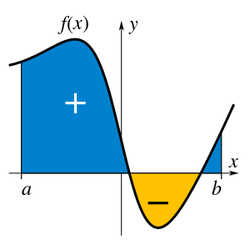Question -21
 k
=
1
∑
n
∫
0
1
f
(
1
−
k
+
x
)
d
x
k
=
1
∑
n
∫
0
1
f
(
1
−
k
+
x
)
d
x
There's integration and summation here in the expression above.
If I were to simplify the expression above, what do I get?
Looking for Top Rank in JEE ? Alright, then go for this set : Expected JEE-Mains-2015-B .
Image Credit: Wikipedia Integration
This section requires Javascript.
You are seeing this because something didn't load right. We suggest you, (a) try
refreshing the page, (b) enabling javascript if it is disabled on your browser and,
finally, (c)
loading the
non-javascript version of this page
. We're sorry about the hassle.
1 solution
I think that in 4th line the upper limit of integral should be 2 − k instead of − k
Log in to reply
yup it seems i made a good mistake. But i changed the limits and worked out the problem and the answers comming to be ∫ 1 1 − n f ( x ) d x .i dont know where i am wrong , i know i AM MAKING A HUGE MISTAKE i tried this method only.can u share your method .(i am amazed how it came right in the first place)
Log in to reply
That's why I firmly believe that the answer is wrong.
Check this explanation:
Since nothing is given about f ( x ) ,take f ( x ) = x .
On simple integration and applying summation I am getting: 2 n ( 2 − n )
Now putting n = 2 ,you will get 0 while the given correct answer gives 2 as answer.
Log in to reply
@Mudit Bansal – yes your explanation is nice and seems to satisfy the fact too,but at the end answers not matching.there's got to be something wrong.
Log in to reply
@Soumya Dubey – Ok either you should report the problem and else I.
let us take the integral first:- ∫ 0 1 f ( 1 − k + x ) d x l e t t = 1 − k + x − > d t = d x n o w : − ∑ k = 1 n ∫ 1 − k − k f ( t ) d t n o w j u s t s u m m i n g i t a l l u p : − − > ∫ 0 − 1 f ( t ) d t + ∫ − 1 − 2 f ( t ) d t + ∫ − 2 − 3 f ( t ) d t + . . . . + ∫ 1 − n n f ( t ) d t n o w : − l e t t h e a n t i d e r i v a t i v e o f f ( x ) b e a f u n c t i o n F ( X ) ∴ { F ( − 1 ) − F ( 0 ) } + { F ( − 2 ) − F ( − 1 ) } + { F ( − 3 ) − F ( − 2 ) } + . . . . . . + { F ( − n ) − F ( 1 − n ) } a s m o s t o f t e r m s a r e g e t t i n g c a n c e l l e d p a i r w i s e w e a r e l e f t w i t h : − − F ( 0 ) + F ( n ) − > F ( n ) − F ( 0 ) ∴ t h e a b o v e f n i s n o t h i n g b u t ∫ 0 n f ( x ) d x